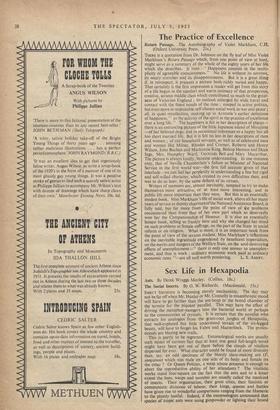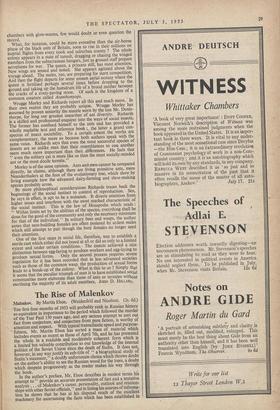Sex Life in Hexapodia
Ants. By Derek Wragge Morley. (Collins. 18s.) The Social Insects. By 0. W. Richards. (Macdonald. 15s.)
INSECT literature is becoming sternly mechanistic. The day may not be far off when Mr. Huxley or Mr. Connolly in misanthropic mood will have to go further than the ant-heap or the brood chamber of the termite for the piquant parallel. This may have the effect of driving the metaphor-mongers into the bacterial world or perhaps to the communities of crystals. It is certain that the novelist who extracts his analogies from the grass-root jungles of Hexapodia, that well-explored but little understood terrain of the six-legged beasts, will have to forget his Fabre and Maeterlinck. The profes- sionals are blazing new trails. This is partly to be regretted. Entomological works are usually such mines of curious fact that at least one good full-length-novel might have been, got out of them before the clouds of vitalism dispersed for ever. What character could be found of more diversity than, say, an odd specimen of the bloody slave-making ant (F. sanguinea) which was male on one side of its body and female on the other ? Or Queen Polistes, a wasp whose presence is enough to abort the reproductive ability of her attendants ? The vitalistic works stand foursquare on the fact that the ants and to a lesser extent the bees, wasps and termites are usually called the mankind of insects. Their organisation, their great cities, their fascistic or communistic divisions of labour, their kjngs, queens and battles have given rise to wonderful comparisons ranging from the Homeric to the plainly lustful. Indeed, if the entomologists announced that species of tropic ants were using gunpowder or lighting their brood chambers with glow-worms, few would doubt or even question the record.
What, for instance, could be more evocative than the air-borne phase of the black ants of Britain, soon to rise in their millions on nuptial flights from every nook and suburban cranny ? The whole colony appears in a state of tumult, dragging or chasing the winged members from the subterranean hangars, just as ground staff prepare aeroplanes for war. The queen, a princess still, has most attention. New wings are tensed and tested. She appears agitated about the voyage ahead. The males, too, are preparing for stern competition. And then the flight departs for some unseen aerial ecstasy where the queen is fertilised perhaps several times before dropping to the ground and taking up the humdrum life of a brood mother between the cracks of a crazy-paving stone. Of such is the kingdom of a common creature called Acanthonvops.
Wragge Morley and Richards report all this and much more. In their own realms they are probably unique. Wragge Morley has assumed by proven seniority the mantle worn by the late Mr. Donis- thorpe, for long our greatest unearther of ant diversity. Richards is a skilled and professional enquirer into the ways of social insects. The former has confined himself to the ants and has provided a wholly readable text and reference book : the latter a grand con- spectus of insect sociability. To a certain extent the works are complementary, the more so because both authors speak with the same voice. Richards says that even the most successful species of insects are so unlike man that their resemblances to one another seem much more important than their differences. He feels that " even the solitary cat is more like us than the most socially-minded ant or the most docile termite."
Morley is of the same opinion. Ants and men cannot be compared directly, he claims, although there are living primitive ants, mere Neanderthalers at the foot of the evolutionary tree, which show by living example how the advanced dairy-farming and slave-making species probably arose. By more philosophical considerations Richards traces back the beginnings of the social instinct to control of reproduction. Sex, he says in effect, is apt to be a nuisance. It diverts attention from higher issues and interferes with the most marked characteristic of the social instinct. This is the law of Hexapodia which reads : " Within limits set by the abilities of the species, everything shall be done for the good of the community and only the necessary minimum for that of the individual." In solitary bees and wasps, the author notes that nest-building females are often pestered by ardent males which still attempt to pair though the busy females no longer need their attention.
One of the first steps in social life, therefore, was to establish a sterile cast which either did not breed at all or did so only to a limited extent and under certain conditions. The insects achieved a nice distinction between egg-laying to produce workers and egg-laying to produce sexual forms. Only the second process requires severe regulation for it has been recorded that in less advanced societies such as those of the common wasp, the production of sexual forms leads to a break-up of the colony. What is this to us ? Simply that it seems that the peculiar triumph of man is to have established social communities more elaborate than those of ants or termites without sterilising the majority of its adult members. JOHN D. HILLABy,



























































 Previous page
Previous page